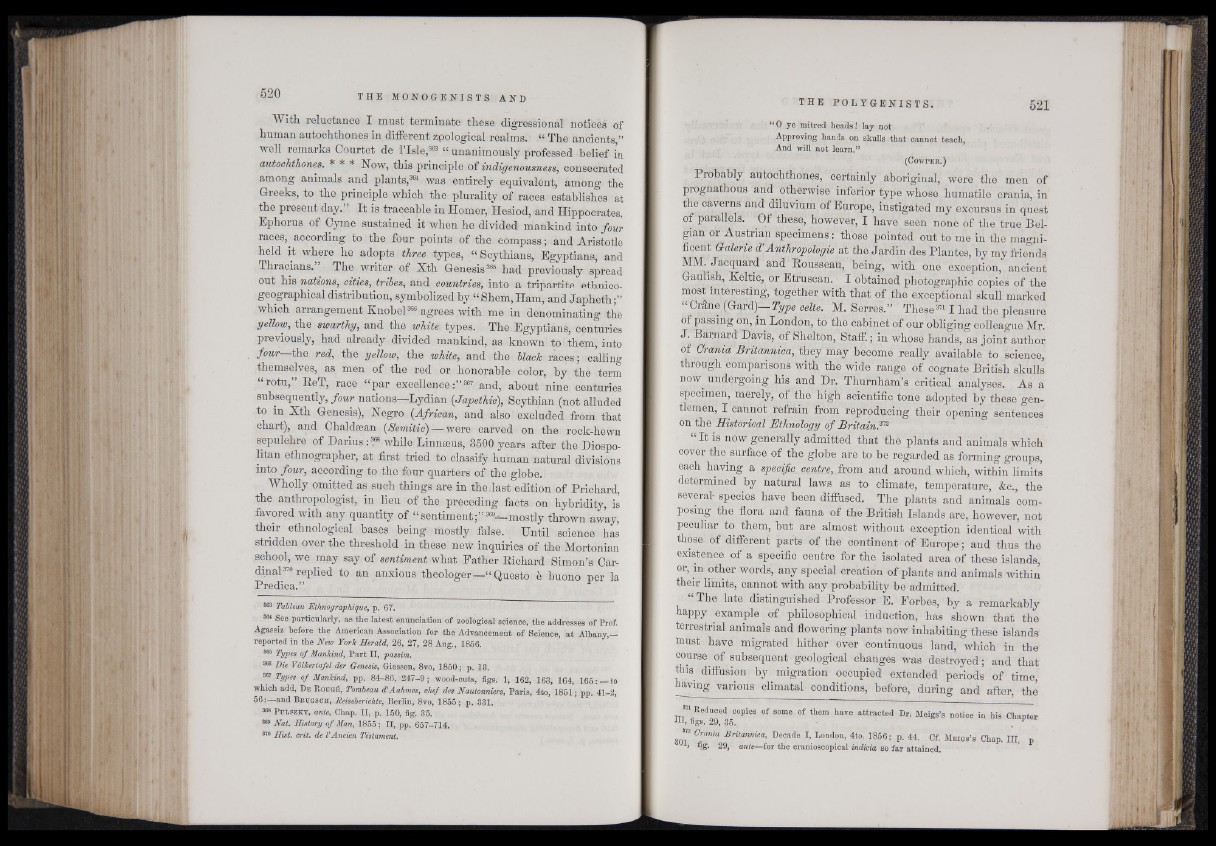
With reluctance I must terminate these digressional notices of
human autochthones in different zpologieal realms. “ The ancients ”
well remarks Courtet de l’lsle,363 “ unanimously professed belief in
autochthones. * * * Now, this principle of indigenousness, consecrated
among animals and plants,384 was entirely equivalent, among the
Greeks, to the principle which the plurality of races establishes at
the present day.” It is traceable in Homer, Hesiod, and Hippocrates.
Ephorus of Cyme sustained it when he divided mankind into four
races,^ according to the four points of the compass; and Aristotle
held it where he adopts three types, “ Scythians, Egyptians, and
Thracians. The writer of Xth Genesis366 had previously spread
out his nations, cities, tribes, and countries, into a tripartite ethnico-
geographical distribution, symbolized by “ Shem,Ham, and Japheth;”
which arrangement Knobel366 agrees with me in denominating the
yelhw, the swarthy, and the white types. The, Egyptians, centuries
previously, had already divided mankind, as known to them, into
four the red, the yellow, the white, and the black races; calling
themselves, as men of the red or honorable color, by the term
rotu, ReT, race “ par e x c e llen c e 387 and, about nine centuries
subsequently, four nations—Lydian (Japethic), Scythian (not alluded
to in Xth Genesis), Negro {African, and also excluded from that
chart), and Chaldsean (Semitic) — were carved on the rock-hewn
sepulchre of Darius: f 9 while Linnseus, 3500 years after the Diospo-
litan ethnographer, at first tried to classify human natural divisions
into four, according to the four quarters of the globe.
Wholly omitted as such things are in the.last edition of Prichard,
the anthropologist, in lieu of the preceding facts on hybridity, is
favored with any quantity of “sentiment;”!369—mostly thrown away,
their ethnological bases being mostly false. Until science has
stridden over the threshold in these new inquiries of the Mortonian
school, we may say of sentiment what Father Richard Simon’s Cardinal370
replied to an anxious theologer—“ Questo e buono per la
Prodioa.”
363 Tableau Ethnographique, p. 67.
384 See particularly, as the latest enunciation of zoological science, the addresses of Prof.
Agassiz before the American Association for the Advancement of Science, at Albany,_
reported in the New Torle Herald, 26, 27, 28 Aug., 1866.
365 Types of Mankind, Part II, passim.
366 Die Volkertafel der Genesis, Giessen, 8vo, 1850; p. 13.
367 Types of Mankind, pp. 84-86, 247-9; wood-outs, figs. 1, 162, 163, 164, 165:—to
■which add, De Eouefi, Tombeau d’Aahmes, chef des Nautonniers, Paris, 4to, 1851; pp. 41-2,
56:—and Bruc.scu, Reiseberichte, Berlin, 8vo, 1856; p. 331.
333 Puiszky, ante, Chap. II, p. 160, fig. 35.
369 Nat. History of Man, 1855; II, pp. 657-714.
370 Hist. arit. de VAncim Testament.
“ O ye mitred heads! lay not
Approving hands on skulls that cannot teach,
And will not learn.”
(C o w p e r . )
Probably autochthones, certainly aboriginal, were the men of
prognathous and otherwise inferior type whose humatile crania, in
the caverns and diluvium of Europe, instigated my excursus in quest
of parallela.' Of these, however, I have seen none of the true Belgian
or Austrian specimens: those pointed out to me in the magnificent
Galerie d’Anthropologie at the Jardin des Plantes, by my friends
MM. Jacquard and Rousseau, being, with one exception, ancient
Gaulish, Keltic, or Etruscan. I obtained photographic' copies of the
most interesting, together with that of the exceptional skull marked
“Cràne (Gard)— Type celte. M. Serres.” These3711 had the pleasure
of passing on, jn London, to the cabinet of our obliging colleague Mr.
J. Barnard Davis, of Shelton, Staff.; in whose hands, as joint author
of Crania Britannica, they may become really available to science,
through comparisons with the wide range of cognate British skulls
now^ undergoing his and Dr. Thurnham’s critical analyses. As a
specimen, merely, of the high scientific tone adopted by these gentlemen,
I cannot refrain from reproducing their opening sentences
on the Historical Ethnology of Britain.™
‘ It is now generally admitted that the plants and animals which
cover the surface of the globe are to be regarded as forming groups,
each having a specific centre, from and around which, within limits
determined by natural laws as to climate, temperature, &c., the
several- species have been diffused. The plants and animals composing
the flora and fauna of the British Islands are, however, not
peculiar to them, but are almost without exception identical with
those of different parts of the Continent of Europe ; and thus the
existence of a specific centre for the isolated area of these islands,
or, in other words, any special creation of plants and animals within
their limits, cannot with any probability be admitted.
“ The late distinguished Professor E. Forbes, by a remarkably
happy example of philosophical induction, has shown that the
terrestrial animals and flowering plants now inhabiting these islands
must have migrated hither over continuous land, which in the
course of subsequent geological changes was destroyed; and that
this diffusion by migration occupied extended periods of time,
having various climatal conditions, before, during and after, the
« Reduced copies of some of them have attracted Dr. Meigs’s notice in his Chanter
11 figs. 29, 35. -
3,2 Orcmia Britannica, Decade I, London, 4to, 1856; p . 44. Cf. M e i g s ’s Chap. HI, p
J-> fig- 29, ante—for the cranioscopical indicia so far attained.